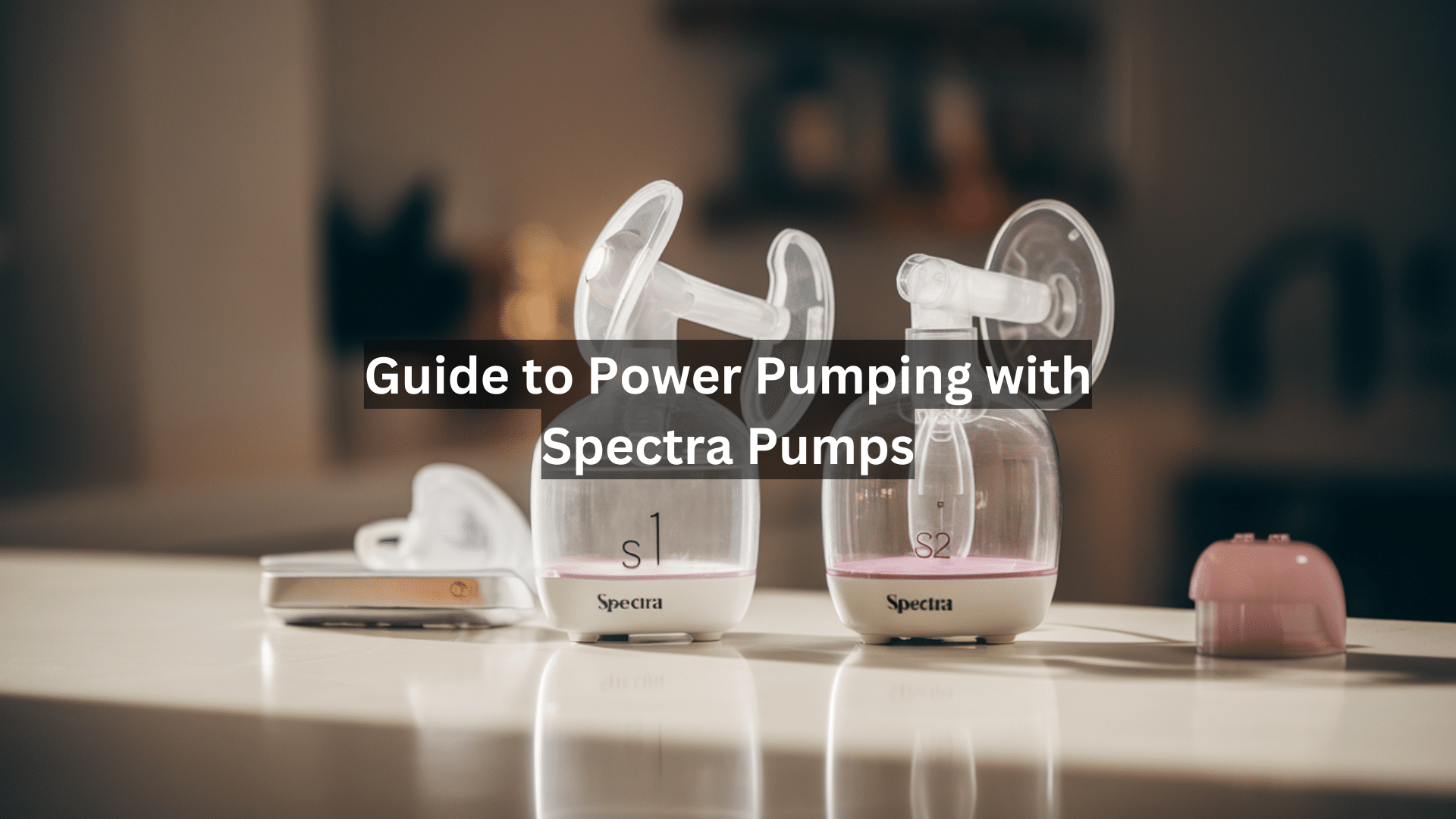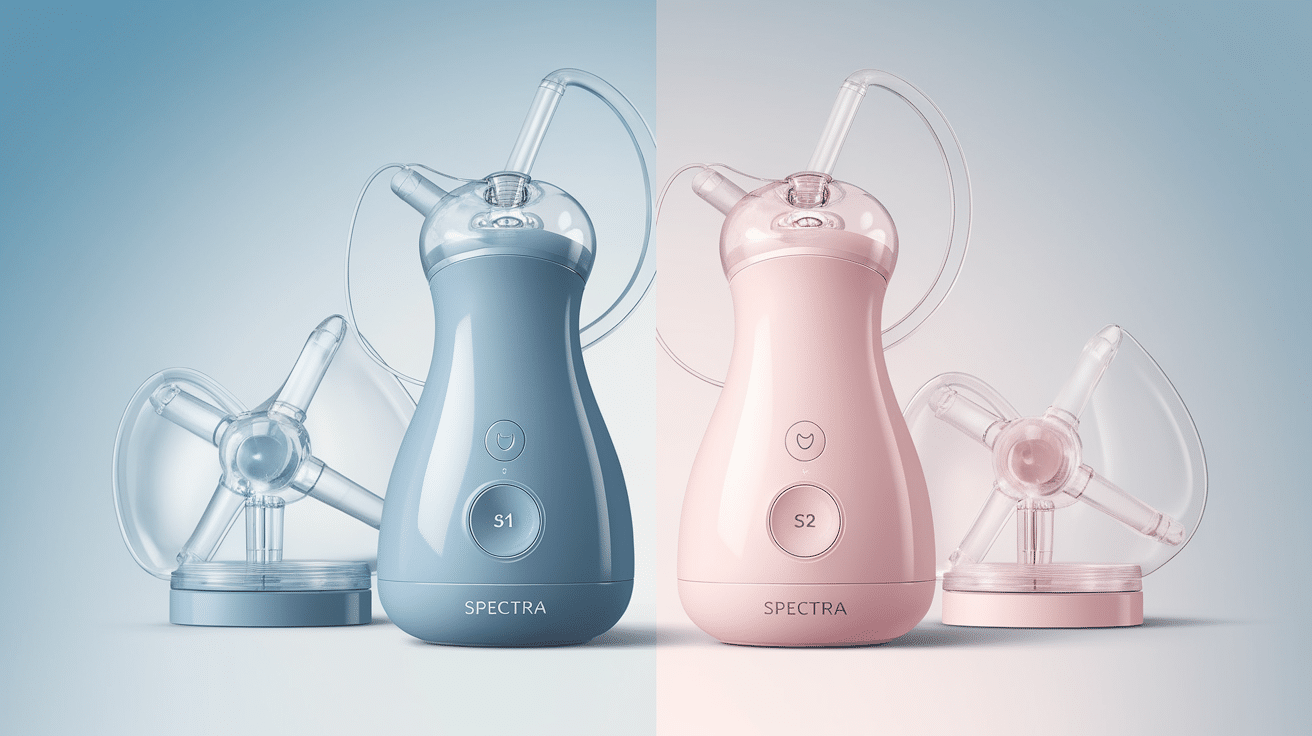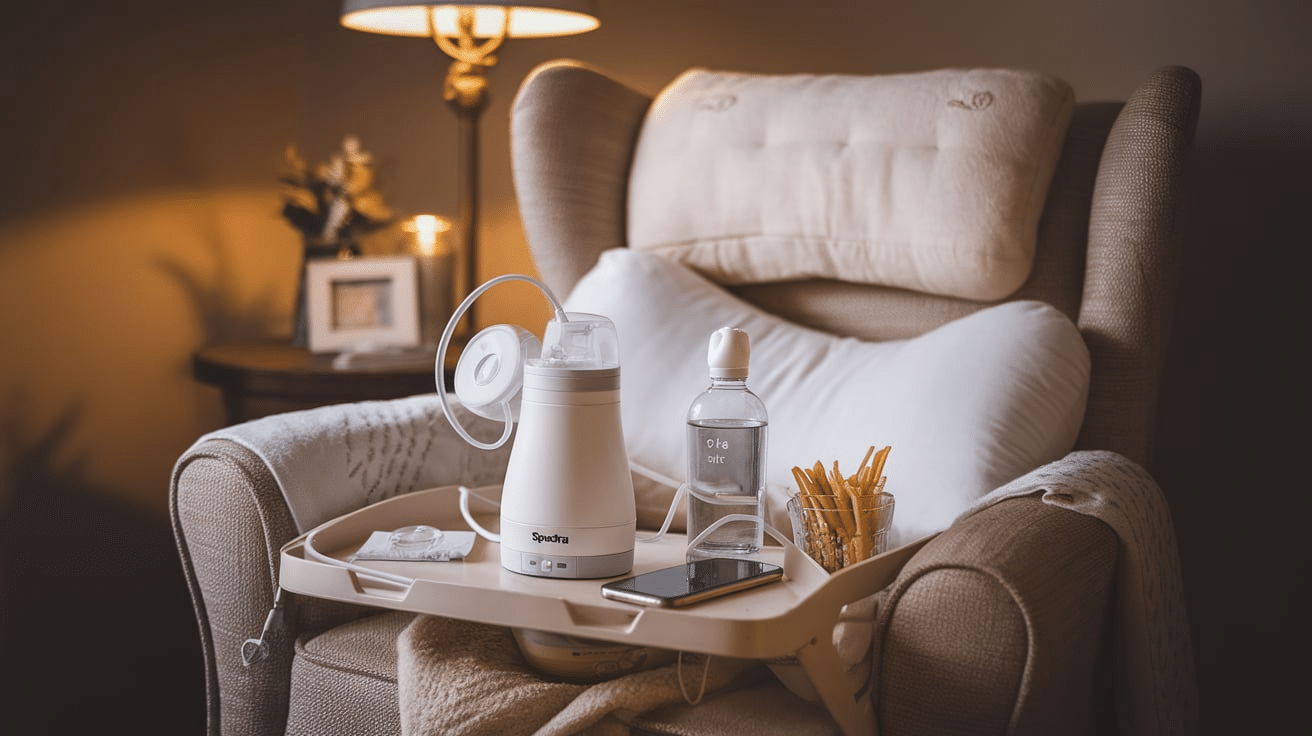
Are you worried about your milk supply? I’ve been there too. After struggling with low milk production, I found a solution that actually works: power pumping with my Spectra pump.
In this guide, I’ll show you:
- Exactly what power pumping is
- How to know if you need it
- Step-by-step instructions to do it right
- Tips for success with your Spectra pump
As a mom who almost gave up breastfeeding, I understand your stress. I tried countless methods before finding this technique, and it changed everything for me. My lactation consultant confirmed this approach is backed by science – it mimics a baby’s feeding pattern during growth spurts.
You can boost your milk supply without expensive supplements or complicated routines. This straightforward method helped me, and I’m confident it can help you, too.
What Is Power Pumping?
Power pumping copies what babies do during growth spurts when they nurse more often. It’s a way to tell your body to make more milk by pumping in short bursts with rest breaks in between. Think of it like interval training, but for your breasts!
The basic pattern looks like this:
- Pump for 20 minutes
- Rest for 10 minutes
- Pump for 10 minutes
- Rest for 10 minutes
- Pump for 10 minutes
This hour-long session signals your body to step up milk production. After a few days of doing this once daily, my supply started to increase.
How Do I Know If I Need to Power Pump?

You might want to try power pumping if:
- Your baby seems hungry after nursing
- Your milk supply has dropped
- You’re returning to work and need to build a freezer stash
- You notice you’re pumping less milk than before
- Your baby had a growth spurt and seems unsatisfied
I knew I needed to power pump when my son started fussing after feeds and my pumping output dropped by almost half. Your body responds to demand, so creating extra demand can help boost your supply.
Why Use a Spectra Pump for Power Pumping?
Not all breast pumps are created equal when it comes to power pumping. After trying multiple brands, I found Spectra pumps to be far superior for this technique. Here’s why:
1. Gentle yet effective suction: Spectra pumps use a unique suction pattern that mimics a baby’s natural nursing rhythm. This is crucial during long power pumping sessions when your breast tissue needs gentle handling. I noticed less soreness even after an hour of pumping.
2. Two-phase technology: The massage mode is a game-changer for triggering multiple letdowns during one session. I can switch between massage and expression modes with a simple button press, which helps empty my breasts more completely.
3. Whisper-quiet motor: Power pumping requires about an hour of your time. With Spectra’s quiet motor, I can watch shows, join video calls, or even put my baby to sleep nearby without the annoying loud noise of other pumps.
4. Portability options: The Spectra S1 comes with a rechargeable battery that lasts through multiple power pumping sessions. This lets me move around my house instead of being stuck next to an outlet. I often power pump while sitting on my back porch!
5. Closed system design: During power pumping, you’ll be handling and storing milk frequently. Spectra’s complete separation between pump parts and motor means no milk particles or moisture can get into the tubing or motor. This keeps everything clean and prevents mold growth.
6. Customizable settings: The adjustable suction levels and cycle speeds let me find my perfect setting. For power pumping, I can start with gentler suction and gradually increase it as needed, which has helped me extract more milk without discomfort.
7. Night light feature: For those middle-of-the-night power pumping sessions, the soft night light means I don’t have to turn on bright lights that might fully wake me up.
I tried power pumping with a different brand first and almost gave up because it was so uncomfortable. Switching to my Spectra made all the difference in my comfort level and milk output. Many moms in my breastfeeding support group report the same experience.
Basic Preparation Steps for Power Pumping

Success with power pumping depends on good preparation. Here’s my detailed guide to setting up for the best results:
Step 1: Pick Your Pump
- Use a Spectra double pump (like the S1 or S2) if possible.
- Check that all parts are clean and dry before starting.
- Make sure your flanges fit correctly – the wrong size can reduce milk output and cause pain.
- Have spare parts ready in case something breaks or gets dirty.
- Test your pump before starting to ensure good suction.
I prefer the S1 because the battery lets me power pump anywhere in my house. Double pumping not only cuts your session time in half but also stimulates more milk production through simultaneous breast emptying. When I switched from single to double pumping, my output increased by about 25%.
Step 2: Choose a Time
Power pumping works best when you can fully focus without interruptions. Consider these options:
- Early morning (4-7 AM) when prolactin levels peak
- After your baby’s first morning feed
- During baby’s longest nap
- When your partner or family member can watch the baby
- Late evening while watching TV
I found that consistency matters more than the exact time. I power pump at 8 PM every night after my baby goes to sleep. This regular schedule helped my body learn when to produce extra milk.
Step 3: Set Up Your Space
Create a comfortable “power pumping station” with everything you need:
- Large water bottle (at least 32 oz) – pumping makes you thirsty!
- Healthy snacks that don’t require two hands (nuts, granola bars, fruit)
- Phone charger within reach
- Entertainment options (remote, tablet, book on a stand)
- Extra breast pads for leakage
- A small cooler or insulated bag for milk storage
- Comfortable chair with back support
- Nursing pillow to rest your arms
I keep a dedicated basket with all these items so I can quickly set up my space. After trying different locations, I found that sitting in a recliner works best for my comfort during the full hour.
Step 4: Plan for About an Hour
The standard power pumping schedule is:
Pump 20 minutes → Rest 10 minutes → Pump 10 minutes → Rest 10 minutes → Pump 10 minutes
Use your phone’s timer or download a special power-pumping timer app. I created a power-pumping playlist that’s exactly 60 minutes long and has songs that change at each interval, so I know when to switch without watching the clock.
Stick to the full schedule even if you stop getting milk during a session. The stimulation, not just the milk collected, matters.
Step 5: Watch for Letdowns
Pay attention to your body’s response during the session:
- First letdown: Usually comes within 1-3 minutes of starting
- Second letdown: Often happens during the second pumping period
- Third letdown: It may be smaller, but it contains fattier milk
When I feel a letdown starting, I increase the suction slightly then reduce it again after the flow slows. This helps empty my breasts more completely.
Learn to recognize the signs of letdown:
- Tingling sensation
- Sudden dripping or spraying
- Feeling of fullness releasing
- Milk suddenly flowing faster
Step 6: Stay Consistent
Consistency is the key to successful power pumping:
- Do it once a day for at least 3-4 consecutive days
- Some moms need a full week to see significant results
- Don’t skip days during your power pumping block
- After seeing results, you can maintain 2-3 sessions per week
I saw my first noticeable increase after 4 days. I now power pump for 3 consecutive days whenever I notice my supply dipping, and it quickly bounces back.
Step 7: Proper Handling of Milk
During your power pumping hour, you’ll collect milk at three different times. Handle it properly:
- Use clean collection bottles for each pumping interval
- Label milk with date and time
- Combine milk from the same power pumping session if desired
- Cool, freshly expressed milk before adding to already refrigerated milk
- Store according to proper breast milk storage guidelines
I keep a small cooler with ice packs right next to my power pumping station so I can immediately cool my milk between sessions.
When Is the Best Time to Power Pump?
The best time depends on your schedule and when your milk supply feels fullest. Some good options are:
- Early morning, when prolactin levels are highest
- After your baby’s first morning feed
- Same time each day to establish a pattern
- When the baby is napping or someone else can watch them
- Evening while relaxing
I found that power pumping about an hour after my morning nursing session worked best for my body. Experiment to see what works for you.
What to Expect During Power Pumping
Here’s what I experienced during power pumping:
- First session: Not much extra milk
- Days 2-3: Small increase in output
- Days 4-7: More noticeable increase
- After a week: Overall higher supply
Don’t get discouraged if you don’t see results right away! Your body needs time to respond. I only got a few extra ounces the first couple of days, but by day 5, I was pumping nearly double what I had been.
Some moms feel extra hungry or thirsty during power pumping days. Listen to your body, eat healthy foods, and drink plenty of water.
Power Pumping While Nursing
You can still power pump even if you’re nursing your baby regularly. Just fit the power pumping session in between regular feedings.
Here’s what works for me:
- Nurse baby as normal
- Wait 30-60 minutes
- Do a power pumping session
- Store the milk collected
- Be ready for the next nursing session
If your baby wants to feed during your power pumping time, always feed the baby first. You can always restart your power pumping schedule afterward.
About Spectra Baby USA
Spectra makes hospital-grade pumps designed by moms and lactation experts. Their pumps feature:
- Closed system design
- Adjustable suction and cycle settings
- Quiet motors
- Nightlights for late pumping
- Options for rechargeable batteries
I chose Spectra after talking to other moms in my breastfeeding group. Many insurance plans cover the S2, so I got mine through them.
Final Thoughts
Power pumping with my Spectra pump saved my breastfeeding journey when I felt hopeless about my milk supply. After just a week of consistent sessions, I saw real results that made all the difference for my baby and me.
The beauty of this method is its simplicity—no special foods, supplements, or complicated routines are required. It requires just you, your pump, and about an hour of your time each day for a short period.
Trust the process and give it time to work. Your body is amazing and will respond to the signals you send it. Be patient with yourself, and celebrate even small increases in your supply.
I’m now confidently breastfeeding my baby with plenty of milk to spare. If I could go from tears over empty bottles to a freezer stash, you can too!
Frequently Asked Questions (FAQs)
Can Power Pumping Replace Regular Pumping Sessions?
No, power pumping should be done in addition to your regular pumping or nursing schedule. Think of it as an extra session specifically designed to boost supply, not a replacement for regular milk removal.
How Long Will It Take to See Results from Power Pumping?
Most moms notice some improvement within 2-3 days, but significant results typically take 4-7 days of consistent power pumping. Your body needs time to recognize and respond to the increased demand.
Can I Power Pump More than Once a Day to Speed up Results?
While you can do two power pumping sessions daily, I don’t recommend more than that. Overworking your body might lead to discomfort or plugged ducts. One good session daily is usually enough.
Will My Milk Supply Decrease if I Stop Power Pumping?
Once your supply increases, you don’t need to continue power pumping forever. Your regular nursing or pumping schedule should maintain your new supply level as long as milk is removed regularly.
Is It Normal to Get Very Little Milk During a Power Pumping Session?
Yes! The purpose isn’t to collect lots of milk during the session itself. The short, frequent pumping signals your body to make more milk later. Don’t be discouraged by small amounts during the actual power pumping.
